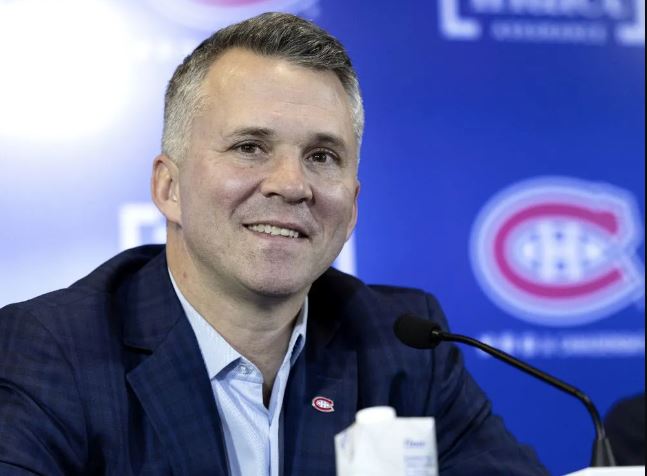
Massive Boost After Trade, Get Ready for More

The Montreal Canadiens have made significant waves this offseason with their strategic maneuvers, but the recent trade for Patrik Laine is not the end of their roster adjustments. While Laine’s addition is a major boost for the team, it highlights another pressing issue for the Canadiens: their current lineup imbalance, particularly in terms of right-handed forwards.
This offseason has been transformative for the Canadiens, signaling a clear shift in both their roster and their long-term ambitions. The signing of Juraj Slafkovsky to an eight-year contract is a testament to the team’s commitment to its young core. Slafkovsky, along with captain Nick Suzuki and prolific goal-scorer Cole Caufield, is expected to be a cornerstone for the Canadiens’ resurgence. This trio is poised to drive the team’s offensive play and serve as the foundation for a more competitive squad.
In addition to Slafkovsky’s extension, the Canadiens have bolstered their defense with new contracts for Justin Barron and Kaiden Guhle. These moves indicate the team’s intent to build around a solid, youthful defense core that will be essential for both short-term competitiveness and long-term success. The acquisition of Patrik Laine from the Columbus Blue Jackets further amplifies this strategy. Laine’s scoring prowess and ability to slot into the top two lines immediately make him a valuable asset for the Canadiens, potentially elevating their offensive capabilities.
However, this influx of talent has brought to light a potential issue: an overabundance of right-handed forwards. With Laine joining Suzuki, Caufield, Kirby Dach, Brendan Gallagher, Joel Armia, Jake Evans, and Josh Anderson, the Canadiens now find themselves with a surplus of right-handed players. This concentration creates a notable imbalance, especially considering that the team’s roster needs to be more strategically balanced between right and left-handed players.
The presence of so many right-handed forwards on the roster has led to speculation about how the Canadiens will address this issue. The lineup could potentially suffer from a lack of variety, particularly in terms of matching opposing teams’ defensive strategies and creating diverse offensive looks. Senior columnist Arpon Basu from The Athletic has pointed out this imbalance, highlighting the possible impact it might have on the team’s performance. With so many right-handed forwards, the Canadiens could face challenges in creating dynamic line combinations that exploit different defensive schemes.
Despite the concerns, the Canadiens’ management might see this situation differently. Historically, many NHL teams have had a mix of left and right-handed players, often leaning towards a more balanced roster. However, the Canadiens might view their predominantly right-handed lineup as an opportunity rather than a problem. In theory, having a lineup with a majority of right-handed shooters could present strategic advantages, such as having more players who can effectively utilize their dominant side in various game situations.
The Canadiens’ coaching staff and front office might also be considering the possibility that this right-handed dominance could actually play to their advantage. A majority right-handed lineup might force opposing teams to adjust their defensive strategies, potentially creating opportunities for the Canadiens to exploit. Additionally, having a higher number of right-handed players might streamline certain aspects of power plays or special teams, depending on how the coaching staff utilizes their personnel.
Nevertheless, the Canadiens cannot ignore the practical implications of their current roster setup. With Laine’s arrival, there are now four forward spots in the lineup that need to be filled, and the imbalance between right and left-handed players becomes even more pronounced. Slafkovsky and Alex Newhook, both left-handed, are expected to fill prominent roles, but the remaining forward spots need careful consideration to ensure a well-rounded lineup.
The Canadiens’ front office will likely be evaluating their options carefully before the start of the 2024 season. The team has to assess whether keeping all four of Armia, Anderson, Evans, and Gallagher is the best strategy or if making a trade might provide better balance and flexibility. The goal for the Canadiens is to improve their performance in the upcoming season, and addressing the current imbalance could be a crucial step towards achieving that.
One potential strategy could involve trading one or more of their surplus right-handed forwards to bring in a left-handed player who can help balance the lineup. By making such a trade, the Canadiens could enhance their depth and variety, providing more options for their coaching staff and potentially creating a more dynamic and effective team structure.
The Canadiens’ front office is no stranger to making bold moves, and the recent trade for Laine is a clear indication of their willingness to make significant changes to improve the team. The acquisition of Laine is a strong statement about their intentions to be more competitive in the near future. However, the management team will need to continue making strategic decisions to ensure that the roster is optimized for success.
As the Canadiens approach the 2024 season, it’s clear that more moves are likely on the horizon. The team’s leadership is undoubtedly aware of the current roster imbalance and the need for further adjustments. Whether through trades or other roster moves, the Canadiens will need to address this issue to maximize their chances of success in the upcoming season.
However, while the acquisition of Patrik Laine is a significant and exciting development for the Montreal Canadiens, it also brings to light a potential roster imbalance that needs to be addressed. The team’s current surplus of right-handed forwards presents a unique challenge, but it also offers opportunities for strategic adjustments. The Canadiens’ front office and coaching staff will need to carefully consider their options and make informed decisions to ensure that the team is well-positioned for a successful 2024 season. With the right moves, the Canadiens can turn this potential problem into an advantage and continue their journey towards a more competitive and successful future.

Leave a Reply